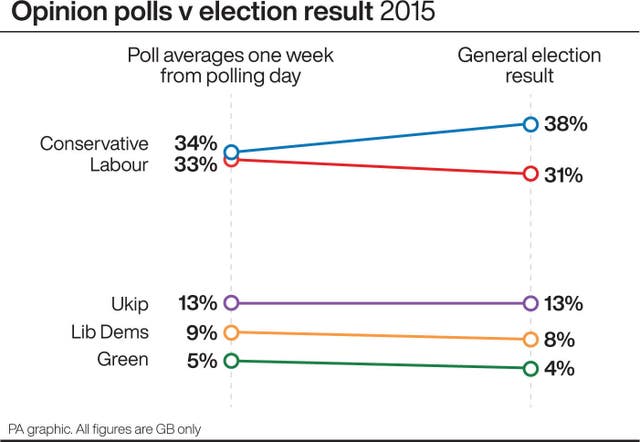How much could the polls change between now and election day?
The previous two elections suggest a lot could happen in the next seven days.

Just one week from today, millions of people across the country will be voting in the General Election.
Opinion polls continue to suggest the Conservative Party enjoys a comfortable lead over Labour.
The latest poll averages put the Tories on 43%, with Labour on 33%, the Liberal Democrats on 13%, the Brexit Party on 3% and the Greens on 3%.
But what are the chances of the polls shifting decisively between now and election day?

At this point in the 2017 election campaign, the polls showed the Conservatives on 44%, with Labour on 35%, the Lib Dems on 8%, Ukip on 4% and the Greens on 2%.
But on election day, the Tories finished on 43% – one point below where they had been a week earlier – while Labour had risen six points to 41%.
The Lib Dems were still on 8%, while both Ukip and the Greens finished on 2%.
The change was enough to deny the Tories a majority and produce a hung parliament.

There was movement in 2015 as well, albeit on a smaller scale and with different consequences.
One week before polling day in 2015, the Tories were averaging 34% and Labour 33%, with Ukip on 13%, the Lib Dems on 9% and the Greens on 5%.
These figures pointed to a hung parliament – but come election day, the Tories opened up a seven-point lead over Labour to finish on 38% while Labour ended on 31%.
Ukip, the Lib Dems and Greens finished on 13%, 8% and 4% respectively.
This was enough to give the Conservatives a small overall majority in Parliament.

The pattern in 2015 and 2017 suggests that what the polls are showing one week from election day is not necessarily the best guide to what will happen on election day itself.
It also serves as a reminder that polls are not predictions, merely snapshots of opinion at a certain point in time.
– All figures quoted above are for vote shares in Great Britain





